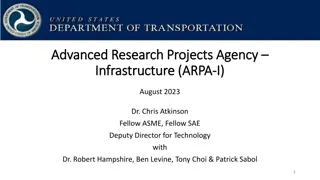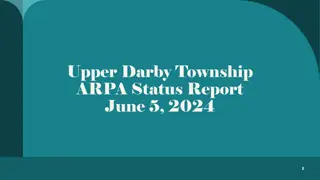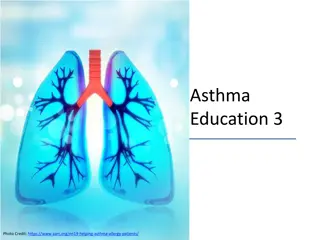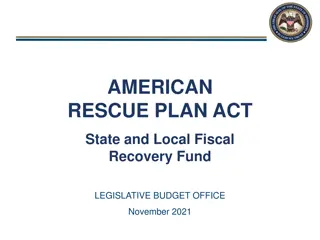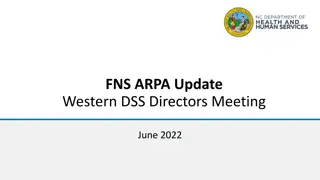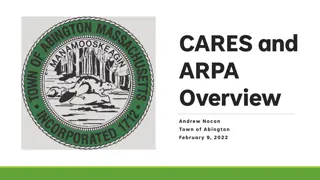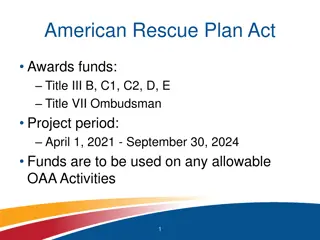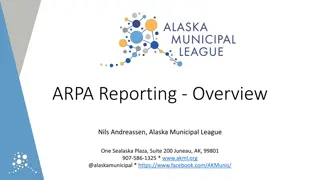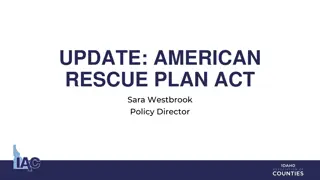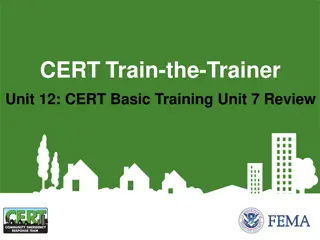American Rescue Plan Act (ARPA) Administration Details
The American Rescue Plan Act (ARPA) provides supplemental and arrearage benefits to LIHEAP-approved households in Indiana. ARPA funding, administered differently than CARES Act, offers various assistance without income loss documentation requirements. Discover how ARPA supports households with past-due balances and additional benefits.
Download Presentation

Please find below an Image/Link to download the presentation.
The content on the website is provided AS IS for your information and personal use only. It may not be sold, licensed, or shared on other websites without obtaining consent from the author.If you encounter any issues during the download, it is possible that the publisher has removed the file from their server.
You are allowed to download the files provided on this website for personal or commercial use, subject to the condition that they are used lawfully. All files are the property of their respective owners.
The content on the website is provided AS IS for your information and personal use only. It may not be sold, licensed, or shared on other websites without obtaining consent from the author.
E N D
Presentation Transcript
American Rescue Plan Act (ARPA) PY 2022 Training Thomas Hartnett-Russell Community Programs Manager August 25, 2021 1
ARPA BACKGROUND World Health Organization (WHO) declared novel Coronavirus Disease 2019 (COVID-19) outbreak a Public Health Emergency of International Concern on January 30, 2020. HHS Secretary Alex Azar declared COVID-19 a public health emergency for the United States on January 31, 2020. Governor Eric Holcomb declared COVID-19 a statewide public health disaster emergency on March 06, 2020. As of this writing, this declaration has been renewed seventeen times and is in effect until August 30, 2021. President Joseph Biden signed American Rescue Plan (ARP) Act of 2021 (Pub. L. 117-2) into law on March 11, 2021. Among other elements, ARPA provided $4.5 billion in supplemental LIHEAP funding, of which Indiana received $114,066,354. 2
ARPA ADMINISTRATION ARPA funding awarded to Indiana May 04, 2021. IHCDA will distribute funds to LSPs prior to beginning of program year. ARPA funding valid until September 30, 2022. ARPA will be administered differently than CARES Act. Whereas CARES Act legislation was written in a narrow and targeted way that sought to address employment losses due to impacts to the economy in the wake of the pandemic, the ARP Act is a much more broad-ranging piece of legislation. In line with this distinction, the ARPA benefits will not have the eligibility requirements of documenting loss of income that CARES Act had. 3
ARPA ADMINISTRATION ARPA will provide two separate benefits. The ARPA Supplemental benefit will provide an additional benefit of up to $350 to every LIHEAP-approved household through PY2022, or until funds are depleted. This will be awarded in the form of one $175 benefit to the electricity utility and one $175 benefit to the primary heating utility. If the household is not eligible for the electricity or heating benefit when eligibility is determined, the household will also not be eligible to receive that corresponding portion of the ARPA Supplemental benefit. If the household was ineligible to receive an electricity or heating benefit at the time of application, but becomes eligible to receive this benefit later in the program year, both the regular benefit and the ARPA Supplemental benefit should be released. 4
ARPA ADMINISTRATION ARPA will provide two separate benefits. The ARPA Arrearage benefit will provide an additional benefit to cover past-due balances on the electric or primary heating source of any LIHEAP-eligible household as of eligibility determination at the time of application. The ARPA Arrearage benefit is to be applied after any eligible crisis is applied to the disconnect or reconnect amount on the bill. The ARPA Arrearage benefit can be applied to disconnect amounts, reconnect amounts, and past-due amounts that are not presenting an immediate crisis. The ARPA Arrearage benefit may not be applied to deposits or any other unallowable LIHEAP charges. There is no cap on ARPA Arrearage claims, but please notify us of any claims exceeding $1,000. 5
ARPA ADMINISTRATION ARPA will provide two separate benefits. The ARPA Arrearage benefit will provide an additional benefit to cover past-due balances on the electric or primary heating source of any LIHEAP-eligible household as of eligibility determination at the time of application. The ARPA Arrearage benefit may be applied to boththe household s electricity and heating bills. The ARPA Arrearage benefit can be applied based on circumstances at the time of application only. That is to say, if an applicant does not present with arrears at the time of application, and at the end of moratorium they are in arrears in excess of their available crisis, ARPA Arrearage may not be applied at that time. Likewise, a household that receives ARPA Arrearage benefits at the time of application may not return at a later day to request additional ARPA Arrearage benefit. 6
ARPA ELIGIBILITY In order to qualify for the ARPA Supplemental benefit, an applicant household must: meet all general eligibility requirements for EAP. qualify to receive a benefit to the applicable utility. In order to qualify for the ARPA Arrearage benefit, an applicant household must: meet the eligibility requirements listed above for the ARPA Supplemental benefit. present with an outstanding past-due balance on the electricity and/or primary heating bill. The outstanding past-due balance may or may not represent a crisis situation. Any active payment agreement or payment arrangement counts as an arrearage for this benefit, even if the applicant is current on the agreement. 7
CALCULATING ARPA BENEFIT ELIGIBILITY In order to calculate the appropriate amount of ARPA Supplemental to award, the benefits must be applied in a specific order. 1. Crisis 2. ARPA Arrearage 3. Regular 4. ARPA Supplemental Local or utility funds may be assessed before or after regular and ARPA Supplemental, depending on their rules and guidelines. However, Crisis and ARPA Arrearage must be the first and second funding sources/benefits applied if a household presents with any past-due balance. This sequence repeats for both utilities for any household that is not total electric. 8
CALCULATING ARPA BENEFIT ELIGIBILITY Example: Applicant is in a total electric household. Applicant presents with a $642 electric bill. The current charges are $192. $450 of the charges are past due, with $138 being needed to avoid disconnection. There is no outstanding deposit. 1. Crisis Applicant receives $138 in crisis to stop disconnection. Applicant will have $362 in crisis remaining to address any additional crisis after moratorium ends. 2. ARPA Arrearage Applicant receives $312 in ARPA Arrearage to address past-due balance. This will bring the bill current. However, current charges are not covered by ARPA Arrearage benefits. 3. Regular Determined based on matrix, this will be applied to current charges. Since applicant is total electric, heating benefit is also included and this will create a positive account balance. 4. ARPA Supplemental Since applicant is total electric, applicant receives $350 in ARPA Supplemental. This will add to positive account balance. 9
CALCULATING ARPA BENEFIT ELIGIBILITY Example: Applicant heats with gas. Applicant presents with a $642 electric bill. The current charges are $192. $450 of the charges are past due, with $138 being needed to avoid disconnection. There is no outstanding deposit. Gas bill is current. 1. Crisis Applicant receives $138 in crisis to electric to stop disconnection. Applicant will have $112 in crisis remaining to address any additional crisis after moratorium ends. Applicant receives no crisis to gas, and has $250 remaining in crisis to gas. 2. ARPA Arrearage Applicant receives $312 in ARPA Arrearage to electric to address past-due balance. This will bring the bill current. However, current charges are not covered by ARPA Arrearage benefits. No ARPA Arrearage to gas. 3. Regular $125 regular to electric current charges. Gas benefit based on matrix. 4. ARPA Supplemental $175 in ARPA Supplemental to both gas and electric. Electric will have $108 positive balance in the end. 10
CALCULATING ARPA BENEFIT ELIGIBILITY Example: Applicant heats with firewood. Applicant presents with a $2,420 electric bill. The current charges are $250, which includes $100 in current usage and $150 in a payment arrangement installment. The payment arrangement is for $2,320. $150 is required to stop disconnection. 1. Crisis Applicant receives $250 in crisis to heating, and $150 crisis to electric to stop disconnection. Applicant will have $100 in crisis for electric remaining to address any additional crisis after moratorium ends. Applicant has no additional crisis remaining for heating. 2. ARPA Arrearage Applicant receives $2,170 in ARPA Arrearage to electric to address past-due balance. This will bring the bill current. However, current charges are not covered by ARPA Arrearage benefits. No ARPA Arrearage to biofuel. 3. Regular $125 regular to electric current charges. Biofuel benefit based on matrix. 4. ARPA Supplemental $175 in ARPA Supplemental to both biofuel and electric. Electric will have $200 positive balance in the end. 11
CALCULATING ARPA BENEFIT ELIGIBILITY Example: Applicant heats with gas. Applicant presents with a $968 electric bill and $1,248 gas bill. Electric bill shows $648 in an active payment agreement with no disconnection scheduled. Gas bill shows a past-due balance of $1,142, with $450 required to prevent disconnection. 1. Crisis Applicant receives $250 in crisis to heating to stop disconnection. Applicant receives no crisis funding for electric bill. 2. ARPA Arrearage Applicant receives $648 in ARPA Arrearage to electric to address payment agreement and $892 in ARPA Arrearage to gas to supplement the crisis on the remaining disconnect and cover the rest of the past-due balance. This will bring both bills current. However, current charges are not covered by ARPA Arrearage benefits. 3. Regular $125 regular to electric current charges. Heating benefit based on matrix. 4. ARPA Supplemental $175 in ARPA Supplemental to both gas and electric. 12
CALCULATING ARPA BENEFIT ELIGIBILITY Example: Applicant heats with gas, but furnace is inoperable. Applicant presents with a $525 electric bill and $120 gas bill. Electric bill shows $225 past-due with all $225 needed to prevent disconnection, and $300 in current charges. Gas bill is from December 2020 and service is disconnected. 1. Crisis Applicant receives $225 in crisis to electric to stop disconnection. Applicant may receive $120 crisis to gas to restore service if furnace is fixed, but is not eligible at time of application. 2. ARPA Arrearage Applicant is not eligible to receive ARPA Arrearage to either utility. Entire past-due balance for electric was covered by crisis, leaving no additional past-due balance. Gas is not eligible for benefits due to being inoperable. 3. Regular $125 regular to electric current charges. Heating benefit deferred until furnace is repaired or replaced. 4. ARPA Supplemental $175 in ARPA Supplemental to electric. Applicant is ineligible for heating benefit at this time, but if furnace is repaired or replaced, applicant may receive ARPA Supplemental to gas, along with regular heating claim and crisis to restore service. 13
OTHER CONSIDERATIONS WITH ARPA ARPA Arrearage should not be used to pay off old debts accrued before the pandemic. ARPA Supplemental is eligible to be awarded to biofuel clients, as well as to clients with utilities included in the rent. These households are not eligible to receive ARPA Arrearage benefits. When communicating with applicants, especially if they ask questions about the ARPA benefit, all attempts should be made to be transparent about the fact that this is a one-time-only supplemental benefit and does not represent a permanent change in the funding we receive or the benefits we will be able to provide. Our intention is to obligate/expend ARPA completely by May 16th. We would very much like to avoid an additional supplemental benefit batch. 14
ARPA BUDGET LSPs may allocate up to 7.5% of total expenditures of ARPA award to Administrative costs. LSPs may allocate up to 4.5% of total ARPA award to Outreach and Eligibility Determination. No Assurance 16, Emergency Services, or Emergency Repair and Replacement may be claimed against the ARPA Award. 15
ARPA BUDGET Because of the one-time, limited nature of this stimulus award, we strongly encourage subgrantees to be thoughtful, innovative, and intentional with how they use the funding. For instance, using ARPA specifically to fund salary increases that create ongoing recurring costs may not be sustainable for next year. IHCDA suggests that this award might best be used to fund innovative outreach activities, infrastructure improvements, technology enhancements, or investing in tools that will help your intake work more efficiently and effectively. That being said, IHCDA is not implementing any additional rules or restrictions on the Administrative or Outreach and Eligibility Determination line items for the ARPA award. 16


